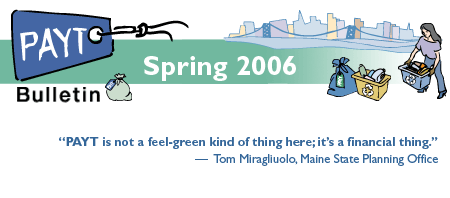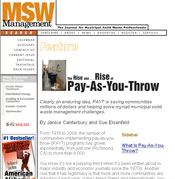PAYT Bulletin: Spring 2006

![]()

The Rise and … Rise of Pay-As-You-Throw
 Once again, Pay-As-You-Throw (PAYT) has made headlines, this time as a feature article in one of the top solid waste publications, MSW Management. The Elements 2006 issue highlighted six case studies of communities across the United States using PAYT.
Once again, Pay-As-You-Throw (PAYT) has made headlines, this time as a feature article in one of the top solid waste publications, MSW Management. The Elements 2006 issue highlighted six case studies of communities across the United States using PAYT.
While increasing recyclables and saving the environment are excellent reasons to start a PAYT program, communities generally turn to PAYT for two pressing issues: to lower waste collection and disposal costs or as an alternative to mandated landfill closures. Take the state of Maine, for example; communities are choosing to implement PAYT programs to solve financial problems. “PAYT is not a feel-green kind of thing here; it’s a financial thing,” says state planner Tom Miragliuolo. Even without incentives from the state, PAYT participation has increased to 137 communities since 1980, about 23 percent of the state’s population.
In neighboring Massachusetts, a state-level decision was made to promote PAYT. Through the flexibility that PAYT programs allow, each community has developed a program that fits its individual circumstances. As of 2004, Massachusetts has 110 out of 351 communities implementing PAYT, and more than half of these communities have seen an increase in recycling rates to 40 percent or greater. The state owes its high record of success to informative outreach and educational programs, allowing decision-makers to fully understand how PAYT works. “Our number one problem is in communities where municipal or political officials don’t understand PAYT and therefore can’t sell it well to stakeholders or plan for it adequately,” states Joseph Lambert, PAYT program manager at the Massachusetts Department of Environmental Protection.
The same educational efforts can be seen in Athens, Ohio, where 80 percent of the population consists of Ohio University students. Athens faced a daunting challenge in reaching and educating a transient population. The city made huge efforts to inform students and other residents about recycling by distributing information packets and enforcing solid waste regulations. Between 1997 and 2001, the community saved about $500,000 by decreasing collected solid waste through PAYT, and also brought in nearly $1 million in revenue through the sale of recyclable materials.
But even these successes might seem modest when compared to San Francisco. This city has been implementing PAYT since 1932 and has seen a waste diversion rate of more than 62 percent. The city’s ambitious goal is to divert 100 percent of waste by 2020. With its “Fantastic Three” program, which includes recycling, composting, and trash removal, San Francisco provides financial incentives to households, allowing them to pay roughly 20 percent less by opting to use a 20-gallon can instead of the standard 32-gallon can, with free pickup of recyclables and compost.
Other communities, like Athens-Clarke County, Georgia, have had a rough start implementing PAYT but have seen the same successful results in the long run. Since 1992, this community has seen a decrease in residential waste by close to 42 percent, enabling the county to reduce its fleet by two trucks. Kansas City, Missouri, had to overcome a tax promise passed in 1970, which guaranteed residents unlimited garbage collection in perpetuity. But the city was able to overcome this challenge through flexibility, allowing up to two bags of trash to be collected for free, and launched a “Recycle First” program, which provides residents with free, unlimited recyclable collection. Kansas City has seen a 30 percent reduction in trash, with 50 percent of residents now recycling. The city anticipates savings of about $2 million per year through the increased efficiency this program will bring.
And in Fort Worth, Texas, with PAYT, recycling has increased from 6 percent to 20 percent, with 70 percent of households now recycling. PAYT has saved the city approximately $7 million, and brings in about $540,000 in revenue through the sale of recyclables.
Read the complete article ![]()
Yet Another Survey Supports Pay-As-You-Throw
 Pay-As-You-Throw (PAYT) has yet again demonstrated its success, this time by a 2005 recycling participation study conducted for the Massachusetts Department of Environmental Protection. Among its most significant PAYT findings, the report shows that 60 percent of residents in PAYT communities claim to “always” recycle, compared to 39 percent of residents in non-PAYT communities, based on a phone survey. Regarding newspapers specifically, 91 percent of residents in PAYT communities “always” recycle, compared to 73 percent of those in non-PAYT communities. Surprisingly, only 35 percent of residents in PAYT communities say that they recycle more because of the program, and 44 percent claim the program has no effect on their recycling habits. Regardless, the recycling rates for in PAYT communities are consistently higher than those in non-PAYT communities, independent of what residents claim to be their motivation. Not surprisingly, communities that began implementing PAYT prior to 1997 have a higher rate of recycling than those who started after that time, showing that practice does make perfect.
Pay-As-You-Throw (PAYT) has yet again demonstrated its success, this time by a 2005 recycling participation study conducted for the Massachusetts Department of Environmental Protection. Among its most significant PAYT findings, the report shows that 60 percent of residents in PAYT communities claim to “always” recycle, compared to 39 percent of residents in non-PAYT communities, based on a phone survey. Regarding newspapers specifically, 91 percent of residents in PAYT communities “always” recycle, compared to 73 percent of those in non-PAYT communities. Surprisingly, only 35 percent of residents in PAYT communities say that they recycle more because of the program, and 44 percent claim the program has no effect on their recycling habits. Regardless, the recycling rates for in PAYT communities are consistently higher than those in non-PAYT communities, independent of what residents claim to be their motivation. Not surprisingly, communities that began implementing PAYT prior to 1997 have a higher rate of recycling than those who started after that time, showing that practice does make perfect.
Communities in Massachusetts that do not currently use PAYT could certainly benefit from it. Self-admitted issues of motivation are the biggest barriers (49 percent) to recycling more. Thirteen percent of those surveyed cite the inconvenience and 16 percent blame whatever program is currently in place in their community for their lack of recycling. When asked if they would recycle more if they had to pay to throw away their trash but could recycle for free, 59 percent said yes, and only 23 percent of residents claimed it would not make a difference in their recycling effort. Seventy-five percent of individuals who claimed to “never” recycle for whatever reason said PAYT would be ample motivation, as did 73 percent of those who claimed to “not always” recycle due to lack of motivation.
Numerous demographic factors influence recycling rates. Being 35 or older, owning a home, living in a single-family home, and having a college degree all increase the odds that an individual “always” recycles. Higher income levels, 10 years of residency in the community, and weekly—as opposed to bimonthly—pickup can also be contributing factors.
What it all comes down to is attitude, however. An astounding 89 percent of residents feel that recycling benefits society, and 84 percent feel that it benefits their specific community. Ninety-two percent of those who claim to “always” recycle feel this way, as do 58 percent of those who “never” recycle, despite their actions. Three-fourths of residents claim that their household is “committed to recycling,” 94 percent of whom “always” recycle. As enthusiastic as many of the residents are about recycling, their actual knowledge of rules and regulations is lacking, however. Only 11 percent of residents are aware of laws banning the disposal of recyclable paper and cardboard, and 15 percent are aware of laws banning the disposal of plastic bottles, jars, and containers. Thirty percent are aware of laws prohibiting the disposal of leaves and yard waste, however, and the majority of residents (60 percent) are aware that it is illegal to dispose of TVs and computer monitors in municipal solid waste.
Pay-As-You-Throw Takes Off on International Flight
Proving the adage that a great idea knows no boundaries, the Pay-As-You-Throw (PAYT) concept is now taking wing internationally. In the  decade since EPA launched its PAYT program, communities in 17 other countries have incorporated PAYT into their solid waste programs. Many are now realizing the environmental and economic benefits of PAYT, and each year, international support for PAYT continues to grow.
decade since EPA launched its PAYT program, communities in 17 other countries have incorporated PAYT into their solid waste programs. Many are now realizing the environmental and economic benefits of PAYT, and each year, international support for PAYT continues to grow.
A report compiled by the Organization for Economic Co-operation and Development (OECD), to be released this summer, supports the effectiveness of PAYT and concludes that communities around the world can benefit both ecologically and economically by using PAYT waste collection programs.
The U.N. of PAYT
The following countries have already implemented PAYT waste collection programs in one or more of their communities:- Australia
- Canada
- China/Taiwan/ Hong Kong
- Germany
- Greece
- Iceland
- Ireland
- Italy
- Korea
- Mexico
- Netherlands
- Palestine/Palestinian Authority
- Slovak Republic/Slovakia
- Thailand
- Vietnam
- United States
More information on PAYT in the European Union ![]()
Take Prejta, Slovakia, for example. This small town, part of the larger city of Dubnica nad Vahom, implemented a PAYT bag collection system in January 2005. In just one year, the town reduced its municipal waste by nearly 80 percent and cut its costs by more than 84 percent. In addition, residents became motivated to separate more materials for recycling; the town’s paper separation increased by nearly 62 percent, plastics by 95 percent, and metals by approximately 20 percent.
Prejta’s system has been so successful, Mayor Juraj Cervinka hopes to expand it and implement a PAYT bag program for the entire city of 26,000 by January 2007. “It will be much harder work than Prejta has been,” Cervinka said, “but we are keeping our fingers crossed.”
Prejta is not the only international community benefiting from PAYT, however. In Germany, for example, PAYT accounts for nearly 25 percent of all municipal waste collection programs, serving approximately 9.2 million households. Korea’s PAYT system, in place since 1995, motivated residents to increase recycling from 15.4 percent 49.2 percent in just one decade. During that same time period, Koreans also reduced their municipal waste generation by nearly 14 percent and reported that they were more likely to avoid using non-disposable products.
Littering: Undesired Side Effect of
Pay-As-You-Throw?
 OK, imagine yourself trying to beat the Pay-As-You-Throw (PAYT) system. Instead of shelling out those few extra dollars for filling up extra trash containers, you decide to risk throwing it out illegally. Then, imagine coming home a week later and finding a hefty fine, as high as $614, in your mailbox. Well, just that scenario occurred to some residents of Brixen, Italy. Numerous residents tried to outsmart municipal waste officials by illegally dumping their waste in public areas. The waste officials searched the waste, pulled out discarded mail, and fined the culprits 50 Euro, or about $61 for a first offense. About 80 percent of the residents fined realized they had been caught and sent in the money without question. Unfortunately, however, many of the perpetrators did not stop after the first infraction, so the municipal waste officials turned recovered mail over to the police, who imposed fines of 100 to 500 Euro, or about $123 to $614.
OK, imagine yourself trying to beat the Pay-As-You-Throw (PAYT) system. Instead of shelling out those few extra dollars for filling up extra trash containers, you decide to risk throwing it out illegally. Then, imagine coming home a week later and finding a hefty fine, as high as $614, in your mailbox. Well, just that scenario occurred to some residents of Brixen, Italy. Numerous residents tried to outsmart municipal waste officials by illegally dumping their waste in public areas. The waste officials searched the waste, pulled out discarded mail, and fined the culprits 50 Euro, or about $61 for a first offense. About 80 percent of the residents fined realized they had been caught and sent in the money without question. Unfortunately, however, many of the perpetrators did not stop after the first infraction, so the municipal waste officials turned recovered mail over to the police, who imposed fines of 100 to 500 Euro, or about $123 to $614.
According to the Handbook on the Implementation of Pay-As-You-Throw, published by the Institute of Waste Management and Contaminated Site Treatment at the Dresden University of Technology, improper disposal of waste – littering – is one of the biggest concerns of critics of the PAYT program. The motive behind littering is generally as simple as the wish to reduce personal costs. Municipal administrators worry that if litter increases as a result PAYT, the economic growth of the community will suffer. Increased litter reduces attractiveness for tourism, lessens real estate value, and increases the cost of street cleaning and waste control, which translates into increased waste charges for the residents.
In reality, the likelihood of increased litter is low. A Duke University study that gathered data from 212 American PAYT communities found that the majority, 54 percent, experienced no increase in litter after PAYT implementation. In contrast, 6 percent of the communities found that littering decreased. Only 19 percent of communities saw an increase in litter. This reality is in stark contrast to perceived assumptions, which often block the adoption of PAYT.
There are two major types of littering: willful and forced. Willful littering is an act of deliberate delinquency. A study by Keep America Beautiful reported that there are three main reasons that people choose to litter. The first is that they feel no sense of ownership toward public property. Second, they believe that someone else will come along and pick up after them. Finally, they do not see anything wrong with adding to the litter if there is already some present. Forced littering, on the other hand, occurs due to lack of alternatives. An example of forced littering is a disabled individual who is not physically able to put his or her waste into the proper waste collection bin and leaves the waste elsewhere.
Several different forms of waste are considered litter in a PAYT program. Any waste that is dumped in unapproved places is considered litter, along with any waste placed in waste containers belonging to other households or in mislabeled containers. Examples of these would be putting waste in a neighbor’s waste collection bin or dumping food waste into a recyclables collection bin.
Smart municipal planners know that to really deter illegal dumping requires a combination of several tactics: a community-wide effort in effective education; a visible enforcement presence; an array of legal diversion options for residential recycling and composting; and fair pricing system for residents. It is probably unwise to try to implement a PAYT program in the absence of any of these deterrents or, if there are a large number of residents who are intent on saving a buck and dumping illegally. Most planners feel it is much better to control the illegal dumping problem and then launch PAYT.
We Want to Hear from You!
EPA would like to promote YOU and your PAYT successes and experiences. Whether you are a community just starting PAYT, one that has been doing it for years, or anywhere in between, we want to hear from you!
We are interested in information on new programs, program expansions, lessons learned, challenges overcome, advice, changes, trends, new documents or reports, community reactions, or any other aspect of your PAYT experiences that could be useful to others.
Please send us an email at payt@icfi.com with your name, affiliation/community, address, phone number, email address, and a brief synopsis of your news. Please also let us know the population of your community and when you started PAYT. We will contact you for more information and include you in our online PAYT Bulletin and/or other informational materials about PAYT. One of the benefits of being part of a progressive, conservation-minded municipal program is the recognition you receive. Don't pass up this opportunity!
Spread the Word!
Please spread the word about PAYT to your neighboring communities, association members, and others in the solid waste arena. Because all of our correspondence will be via email from now on, please send an email to us at payt@icfi.com with email addresses of anyone you think would be interested in joining our mailing list and receiving the PAYT Bulletin.
EPA530-N-06-004
![[logo] US EPA](../gif/logo_epaseal.gif)